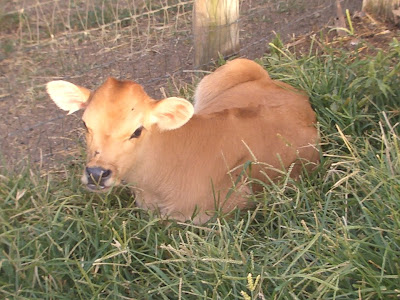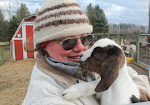I have been on a goat-buying spree these last few weeks and there's still one to come on Monday. With the goat meat flying out of the freezer at the Carlisle Central Farmers Market and Eid rapidly approaching, when the 4-H kids had 'leftovers' from the local fair and their Round-Up, I offered to purchase some of them. In the process, I've also ended up with a pair that will go in to the breeding herd and a new buck.
 You can tell these two boys know what time the dinner bell gets rung around here. Yes, that's an Alpine, but he was intact and unblemished. He'll do fine for a small family's Eid dinner.
You can tell these two boys know what time the dinner bell gets rung around here. Yes, that's an Alpine, but he was intact and unblemished. He'll do fine for a small family's Eid dinner. With tags in their ears and no brains...errr, I mean testicles...these lucky fellas are destined for individually packaged cuts at the market and two will be the guests of honor at the annual goat roast.
With tags in their ears and no brains...errr, I mean testicles...these lucky fellas are destined for individually packaged cuts at the market and two will be the guests of honor at the annual goat roast.  And this is Rose. She belonged to one of the younger 4-H kids and I fell in love with her coloring the first time I saw her. She's a meat/milk cross and while a bit on the leggy side for a meat goat and lacking a milking udder, I'm still enamored with her coloring and look forward to breeding her to another new addition: Sampson.
And this is Rose. She belonged to one of the younger 4-H kids and I fell in love with her coloring the first time I saw her. She's a meat/milk cross and while a bit on the leggy side for a meat goat and lacking a milking udder, I'm still enamored with her coloring and look forward to breeding her to another new addition: Sampson. This framey, purebred Boer buck sired a number of kids for happy 4-Hers this year. Looking at his offspring from this past February, they've gained nicely. He will serve well as a meat production buck. After servicing the ladies of Painted Hand, he'll be off to continue a life of love at Dream Thyme Farm in western Pennsylvania.
This framey, purebred Boer buck sired a number of kids for happy 4-Hers this year. Looking at his offspring from this past February, they've gained nicely. He will serve well as a meat production buck. After servicing the ladies of Painted Hand, he'll be off to continue a life of love at Dream Thyme Farm in western Pennsylvania. 














